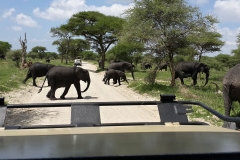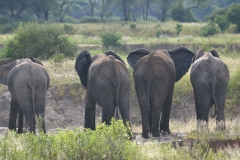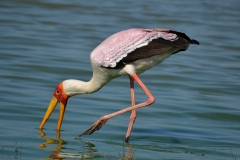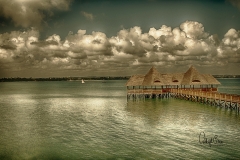











The Usambara Mountain is an upland area which lies to the south-east of Mount Kilimanjaro in Tanzania Northeast
These mountains are part of the Eastern Arc, an ancient range which runs from the Shimba Hills in Kenya down to the Udzungwa Mountains in southern Tanzania.
They are ecologically very important since they massively pre-date the more recent volcanic landscapes of this region and host a prodigious number of endemic species, leading them to be known as ‘the Galapagos of Africa’.
They are estimated to be at least 100 million years old and the rocks forming them may be as much as 600 million years old. The mountains are home to an exceptional assortment of plants and animals and represent one of the highest degrees of biodiversity on the continent.
The range is divided into two by the north-south Lwengera Valley.
To the west, walking trails in the mountains are generally accessed from the historic village of Lushoto.
To the east the Amani Nature Reserve contains some of the most bio-diverse rainforest in Africa.
Lushoto
This leafy highland town is nestled in a fertile valley at about 1200m, surrounded by pines and eucalyptus mixed with banana plants and other tropical foliage. It’s the centre of the western Usambaras and makes an ideal base for hikes into the surrounding hills.
Lushoto is also the heartland of the Wasambaa people (the name ‘Usambara’ is a corruption of Wasambaa or Washambala, meaning ‘scattered’).
Local culture is strong. In Muheza and parts of the Tanga region closer to the coast, Swahili is used almost exclusively. Here however, Sambaa is the language of choice for most residents.
Sight Seeing while in Lushoto
Irente Viewpoint (5-6 hours, 15km)
From Lushoto, hike to this outlook for spectacular views of the village of Mazinde and the Maasai plains almost 1000 meters below. Eat lunch at the Irente Biodiversity Farm in their beautiful flower garden.
Magamba Rainforest (5-6 hours)
Walk through villages and farm land to the lush rainforest where you can see black-and-white Colobus monkeys. On the way back, pass by the historic royal village of the Kilindi (the Washambaa ruling clan) and an old German bunker dug during World War I.
Bangala River (5-6 hours, 15km)
Beginning at Mbuzii, descend slowly down the steep slopes of the Bangala River Valley toward the rising savannah heat. Visit a tree nursery, see traditional irrigation systems, and take in breathtaking views of the Maasai Plains.
Mkuzu Waterfall (5-6 hours, 15km)*
From Muller’s Lodge or Migambo Village, walk through the colorful forest to this local waterfall. Extend your tour by climbing Migambo peak (2400m high!).
Lushoto Town Tour (2-3 hours)
Explore Lushoto and learn about its rich history. View old structures from the town’s German colonial period. On Sunday and Thursday, this tour can be combined with a visit to the colorful Lushoto market.
Montessori Sisters of Ubiri (3-4 hours)
A short walk from Lushoto, visit this beautifully landscaped Catholic mission. Learn about, taste, and buy their locally made cheese, wine, and jams.
Growing Rock (5-6 hours)
From Soni, walk through the villages of Shashui and Kwemula to Kwamongo Peak (“God’s Peak”), famous for its multicolored butterflies and spectacular views of Lushoto and the Handeni plains. Stop by the Soni waterfalls on your way back to Lushoto.
Amani Nature Reserve
Nestled at the base of the central Usambara Mountains, the Amani Nature Reserve is well off the beaten path of the usual safari circuit, but makes a perfect stopover on longer trips and while driving to the Swahili Coast. It’s quiet, tranquil setting offers the perfect opportunity to relax from the rigorous schedule of vehicle-based safaris.
Although the area has been the focus of conservation efforts and botanical research for over a century, the Amani Nature Reserve has only been a protected area since 1997. International efforts to preserve the beauty of the Usambara forests within its boundaries have met with much local success.
Guided nature walks are a unique feature of the nature reserve and offer an exciting opportunity to view the flora and fauna of the area up close. For the aspiring African botanist, Amani Nature Reserve’s incredible diversity of plant life – between 600 to 1,000 different species – is sure to attract.
Amani Nature Reserve is a centre for biological diversity. The floristic composition is very diverse and there are 2012 vascular plants species per hector. Thus a large proposition of the endemic species are found within Amani Natural Reserve. The Reserve have been likened to the African equivalent of the Galápagos Islands in terms of their endemism and biodiversity. Therefore it is considered one of the most important forest blocks in Africa.
GARDEN:
Research centre tour: This takes 1-3 hours walk around the plantation of ABG and in the immediate surroundings of the National Institute for medical Research Amani centre.
MBOMALE HILL TRAIL
This is 4 km walk for a round trip for about 1-3 hours. This includes a climb of about 150m through a natural forest and plantations of ABG to a fine view of the surrounding country side.

With a surface area of 68,800 sq km (26,600 sq mi), Lake Victoria is Africa’s largest lake. In addition, it’s the largest tropical lake in the world, and the planet’s second largest freshwater lake. Only North America’s Lake Superior is larger.
An irregular quadrilateral in shape, Its waters fill a shallow depression in the centre of the great plateau that stretches between the Western and Eastern Rift Valleys.
Many archipelagos are contained within the lake, as are numerous reefs, often just below the surface of the clear waters. Lake Victoria has more than 200 species of fish, of which the Tilapia is the most economically important.
The Kagera River, the largest and most important of the lake affluents, enters the western side of Lake Victoria just north of latitude 1° S. The only other river entering from the west is the Katonga, north of Kagera. The lake’s only outlet is the Victoria Nile, which exits from the northern coast.
The Lake Victoria region is one of the most densely populated in Africa; within 50 miles (80 km) of its shores live several million people, nearly all Bantu-speaking. There are local steamer services around the lake
Mwanza City
The city of Mwanza is the major Tanzanian port on Lake Victoria and a major centre of economic activities in the region. The lake borders the country’s East African neighbours – Uganda to the north west, and Kenya to the north east.
Export and transport among the countries is a foundation of Mwanza’s economy. Around the city of Mwanza, the land is primarily devoted to agricultural enterprise. Tea, cotton and coffee plantations throughout the area produce large volumes of cash crops that pass though Mwanza on their way to market. The town’s industrial harbour and busy streets make it a prosperous and busy place to explore.
For visitors, the city makes a good base from which to explore the nearby Rubondo Island National Park and the western parts of the Serengeti.
Rubondo Island National Park offers pleasant day-hikes and bird watching around the lake shore. Mwanza’s proximity to the western Serengeti makes it a necessary stop for visitors who want to experience a less bust part of the park and see the magic of the Serengeti without the parade of safari vehicles and seasonal crowds. Mwanza is also the centre of the Sukuma tribe, the largest tribe in Tanzania, who have inhabited and farmed the region for centuries. Cultural tourism programmes to their local villages and farms can be arranged through the local cultural centres.
Rubondo Island National Park
Located on the south-west shores of Lake Victoria, Rubondo Island National Park includes Rubondo Island and several other small islands of Lake Victoria.
The park boasts for its rich and diverse variety of butterflies and bird life, easily viewable from the lake shore. The rare Sitatunga, an extremely endangered amphibious antelope, can sometimes be viewed escaping from the charging predators by hiding and camouflaging itself in the lake shore marshes.
A visit to Rubondo Island National Park offers visitors a break from game viewing in the tranquil peace of a lake shore setting. Exploring the islands within the park creates an excitement for day trips. Fishing expeditions into Lake Victoria are easily arranged through the major lodges. Rubondo Island National Park is a relaxation from the rigorous safari circuit and a relaxing place from which to explore Lake Victoria.
Park attractions are a variety of water birds , Eurasian migrants and introduced African grey parrots, High density of African fish eagles are distinctly seen here.
Also you can site animal species like Sitatunga, Elephants, Giraffes, Hippos, Bushbucks, Pythons, Crocodiles, Chimpanzees (not fully habituated), Bush pigs and Suni.
Another attractions are …Magnificent view of one of the last remaining representatives of evergreen dense primary lowland Congolese forest with a unique habitat mosaic in the midst of high biodiversity value,
Clear sighting of both sun rise and sun set,
“Birds Islands”, breeding sit for water birds & a Crocodile Island
different sights which together bring the aesthetic value of the park thus adding to visitors satisfaction.

Lake Tanganyika is the world’s longest (660km), deepest in Africa and second-deepest in the world (more than 1436m) and second-largest (by volume) freshwater lake. At somewhere between nine and 13 million years old, it’s also one of the oldest. Thanks to its age and ecological isolation it’s home to an exceptional number of endemic fish, including 98% of the 250-plus species of cichlids. Cichlids are popular aquarium fish due to their bright colours, and they make Tanganyika an outstanding snorkelling and diving destination
Lake Tanganyika is situated on the line dividing the floral regions of eastern and western Africa, and oil palms, which are characteristic of the flora of western Africa, grow along the lake’s shores. Rice and subsistence crops are grown along the shores, and fishing is of some significance. Hippopotamuses and crocodiles abound, and the bird life is varied.

Lake Nyasa, also called Lake Malawi, lake, southernmost and third largest of the East African Rift Valley lakes of East Africa, lying in a deep trough mainly within Malawi.
Lake Nyasa (Nyasa means “lake”) is located at the south-west of Tanzania, The lake lies in three countries, Tanzania , Malawi and Mozambique. It is the third largest in Africa (after Lake Victoria and Lake Tanganyika) with 550 kilometers length and 75 kilometers width, covering an area of more than 11,400 square kilometers. In some parts, the lake is as deep as 700 meters.
The Lake lies in the sided walls of mountain ranges: the forested Livingston Mountains and Nyika Plateau, which provide the magnificent view of the lake from far and the landscape for hikers and backpackers.
Lake Nyasa is also among the Great Rift Valley’s lakes, which shares some of the characteristics with lake Tanganyika. The lake has a distinctive characteristic: 14 rivers pouring their waters into the lake, and only one river which flows out to the sea, River Shire.
The Lake also has a lot of names such as “Lake of stars” which is provided by the lovers who trip their and discover it one of the dreamy and romantic destination in Eastern Africa. It is situated between Malawi, Mozambique as well as Tanzania. It has so many things to offer such as numerous opportunities for water sports as well as diving. The lake is enormously rich with diverse fish species and is one of the most appealing lakes that offer unforgettable underwater views!
Some parts of the lake offer nice beaches and places to swim. Matema, in the northern part of the lake is considered to be the best beach for people who like to relax swim along the lake shore. In contrast to other lakes the water of lake Nyasa is bilharzias free. There are also caves and interesting waterfalls to see.
Other activities include local canoeing ride down the river, hiking on surrounding mountains.
Though Lake Nyasa does not receive many tourists, the lake is magnificently attractive and is rich in crocodiles and hippopotamus. For Fish lovers, Lake Nyasa is biologically the most diverse lake, containing approximately 30% of world’s cichlid species (colorful fish which are easily seen in the lake’s clear water)

Lake Chala is a unique caldera lake, and is thought to be the deepest inland body of water in Africa. This lake is fed by underground springs from Mt. Kilimanjaro.
The lake has a great diversity of life. From lush lake shore forest to stunning volcanic savannah; from river beds marvelously carved through ancient rock, to thick bush or open ‘mbuga’. Walking at Lake Chala is a magical experience that will put you back in touch with nature.
The lake is fed by groundwater flows, which come from Mount Kilimanjaro, fed and drained underground with a rate of about 10 million m³ / year. Depending on the time of year, it ranges in colour from deep blue to turquoise and green, it is surrounded by a 100 metres high crater rim.
Chala has a huge variety of amazing trees, grasses and plants; some are unique to the area. According to the time of year there are hundreds of species of butterflies and birds, including spectacular birds of prey. The African Fish Eagle, with its haunting techniques, Verreaux’s Eagle, Augur Buzzards and many other species of birds can be seen around the crater walls. Wild mammals do vary including Blue Monkeys, Colobus Monkeys, baboons, dik-dik, kudu and elephant. Chala is an untouched part of a truly ancient land and a must visit place.
Activities at this lake: walking safaris, canoeing, swimming and fishing.